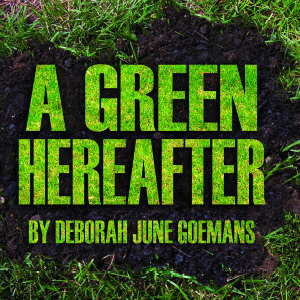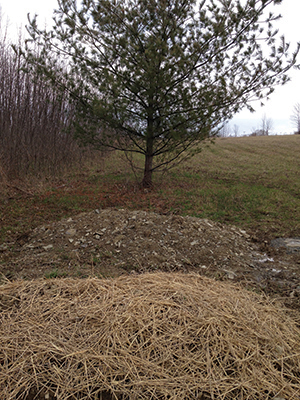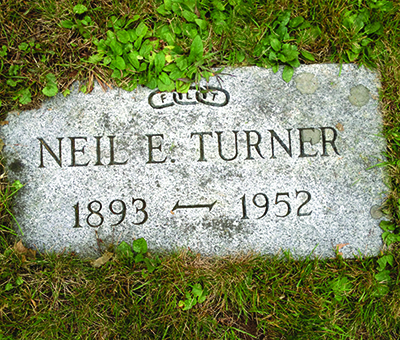A Green Hereafter

MY FRIEND MARY and I tread lightly upon the early spring awakenings at the Greensprings Natural Cemetery in Newfield, New York. Jennifer Johnson, our guide and the burial coordinator at Greensprings, has no such qualms. Johnson is one of those rare beings—someone with bright, numinous energy who plays the Plains Indian flute, combined with a deep-into-the-earth, let’s-get-it-done practical side.
“I want my body to be my last gift to the earth,” she says as she inflates the tire of her all-terrain vehicle. While I’m in no hurry to die, after spending the day with her, I realize I’d like Johnson to coordinate my funeral.
Death at Greensprings is friendly like that. A cardboard coffin displayed in the office states, “Save a Forest—Plant Yourself.”

The graves of a married couple buried side by side at Greensprings Natural Cemetery in Newfield, NY. Photo by Deborah June Goemans.
I’m here to learn about green burials—the eco-friendly movement towards using humans as natural compost to reclaim the land for indigenous flora and fauna. I was inspired to learn more about this when I read a recent news report about a start-up company in the UK that received a grant from the Arts Council England North West to design prototypes of eco-friendly coffins made out of recycled and biodegradable materials. It called to mind a business venture some friends embarked upon years ago. And, as thoughts were triggered, it reminded me of my grandfather.
I was raised on a flower farm in Cape Town, South Africa, where life was full of contrasts—petals and manure, fresh air and insecticides, flood and drought, mud and dust, bees and earthworms. The manure pile was my trampoline, rows of daffodils were my friends, empty boxes were my play houses, trees were my jungle gym, the tik-tik-tik of the sprinkler was my alarm clock, and in the frying pan of summer, a tin bucket filled with water became my personal swimming pool. But my favorite game was to sit in the garden next to a tap, turn it on full blast, and build mud tunnels. I loved how the water from the tap would try to escape the dry earth but instead fell neatly into my trap—a handmade dam—where it turned the dust into soft, pliable mud to be sculptured by my will into roads and tunnels and mud pies. I would sing, loudly and tunelessly, and bury my hands deep as the mud turned my nails into black crescent moons.
Every Sunday at four o’clock precisely Grandpa and his second wife, Violet, came to visit us. Grandpa had a small, white, curly-haired dog called Pixie—a frothy, mean animal. “No, no she didn’t bite you, her teeth merely trembled just so,” Grandpa told me, holding up his shaky arthritic fingers to illustrate the teeth as an inch apart. Clearly the dog was physically unable to gnaw. So Pixie may not have had any bite, but my grandfather’s words did.
“Are you a good boy?” Grandpa would ask me, by way of a greeting. “I’m not a boy!” I’d retort, stamping my foot. “Oh, so you’re a naughty boy,” he’d say.
I suffered from life-threatening asthma, and when our three pet rabbits died in a mass plague, I became terrified of death—of not ever being able to breathe. Other people’s grandpas might have comforted them by speaking of eternal life and the joy of one day reuniting with Twitchy, Richie, and Rabbie in heaven. But not my grandpa. He put me on his knee and said there was no such thing as heaven; dying was just like going to sleep, “and then we will be eaten by earthworms and the earthworms will heal the earth.”
They say there are no atheists in foxholes, but Grandpa’s journey from Judaism to atheism was walked in the trenches of World War I, and after that the idea of an eternal sleep came to him as a blessed release. For him, blessed release—for me, cold terror. Now, with Grandpa’s cold comfort, in addition to being scared of death I was also scared of going to sleep. And scared of earthworms. Every night his words gnawed me into a sleepless toss.
Just before Grandpa died, my mother took us to the hospital to visit him. While my mother was talking to the nurse, I went to Grandpa’s bedside and leaned over the cold, prison-like cot railings. His breathing was shallow and his cheeks had fallen into the place where his words used to bite. Our eyes met. I smiled. “Bah,” he said, as he gestured me away. I’m not sure if it was his last word, period, but it was the last word he ever said to me.
But time has brought an understanding and appreciation of my grandpa’s biting words. I’ve made peace with the idea of a dreamless sleep where cold is not ice and hot is not hell. Grandpa’s worms have turned into a soft and gentle humanistic mantra of peace and comfort. But what to do with my body when I die? That is the question.
Burn, bury, dump, or eat—those are the choices given in Monty Python’s notorious “Undertakers” sketch. And it turns out that every choice comes with a price, even Grandpa’s choice.
We basically dumped him. It was what he wanted.We donated his body to science, a good form of dumping, and that was the end of Grandpa. No service, no burial or cremation. Just gone, gone, gone—and, presumably, eventually eaten by worms. Or fish. Donating one’s body to science is a human kindness, but for the family left behind, death without ritual feels incomplete, like the extraction of a tooth without the benefit of Novocain. “But where is he?” I asked, sobbing and trembling as my mother tried to hush me to sleep.

The family plot of the author’s husband at Oak Ridge Cemetery in Southbridge, MA. Photo by Deborah June Goemans.
Humans need rituals, and traditional burials in modern cemeteries are good at that. But they are the pits environmentally speaking. There are the hundreds of thousands of gallons of embalming fluid used every year to pretty up decaying bodies for viewing at the funeral. Add to that the hardwood, steel, copper, and bronze used to create the caskets and the million and a half tons of reinforced concrete used in vaults, plus the upkeep of the pristine, never-an-earthworm-to-be-found lawns, and you’re talking big, big carbon footprint.
But despite the environmental drawbacks, there is some beauty to be found in the old family cemetery. It offers the mark of the human: the evidence and artifacts of a life. A few years ago, my extended family met in Hillegom in the Netherlands to celebrate the one hundredth anniversary of my paternal grandparents’ wedding. We are an unusual family in that my grandparents had sixteen children who scattered far and wide, so all the cousins came together as a diverse group seeking unity. The party was fun, but for me the deeper sense of unity came at the gathering at the family cemetery where we read the (many) names of our family members who’d died in the past one hundred years and we placed flowers on our ancestral graves. As I had not been able to attend either of my parents’ burials in South Africa, that gathering in the Netherlands gave me a personal sense of closure for them as well.
The next choice, burning (cremation), has grown in popularity and social acceptance. At present, 43.8 percent of human remains in the United States are cremated and that figure is rising every year. It’s more expensive than Grandpa’s dump, of course, but cheaper and much more environmentally friendly than a traditional roll-out-the-fake-green-carpet burial. But cremation has its own environmental challenges, including the burning of plastic, mercury, and fossil fuels.
According to Barbara Kemmis, the Executive Director of the Cremation Association of North America, it’s imperative that we know what we’re burning. Plastic and Styrofoam within the shroud or coffin, the clothing of the person, or mementoes are of particular concern but easily managed. Mercury from dental amalgams spewing into the environment is a little more difficult to manage. The United Nations Environment Programme’s Global Mercury Assessment 2013 states that “global emissions from use of mercury in dental amalgams resulting from cremation of human remains are estimated at 3.6 (0.9‒11.9) tonnes [metric ton] in 2010.” One way to fix this is to remove dental amalgams prior to cremation and also by using special filters within the cremation chambers. Unfortunately, the United States is way behind Europe on this issue, and the EPA has yet to create laws regulating the release of mercury into the atmosphere.
Another issue with cremation is, of course, the energy required to burn the body. According to Kemmis, the carbon footprint of the typical cremation—transporting the body to the crematory, cold storage for an average of forty-eight hours so that loved ones may assemble to say farewell, and then burning the body and handing the ashes over to the family for disposal—is about equal to the deceased living one extra month. Put that way, one extra month of “lights on, no one home,” doesn’t sound that bad, especially when compared to the environmental cost of a cemetery burial.
Realizing the wild fires of cremation may soon put them out of business, some cemeteries, like the beautiful Lakewood Cemetery in Minneapolis, Minnesota, are creating mausoleums for the storage of cremains as a way to create a lasting memorial for our descendants. Instead of scattering our ashes to the four winds or storing them in the mud room next to the dog’s ashes, it’s a modern version of the old family cemetery—a place where our ancestors have been noted in the book of life, and where we can sit a while to reflect on the meaning of life and death.
But no matter how it’s wrapped, cremation removes the body from the cycle of life. And that’s just not green. A green burial isn’t just about disposing of human remains. It’s about planting ourselves firmly into the food chain without embalming fluids or fancy vaults or coffins. In Monty Python parlance, to be eaten.
And so twenty years ago when I heard that my friends had bought a cardboard coffin franchise, it made perfect sense to me. Cardboard coffins, for burial in natural green space cemeteries without embalmment or headstones, are cheap, clean, and environmentally friendly. And they make things a lot easier for the earthworms that eat us. What’s not to love? And yet, when I bumped into my friends a few years later and asked how the coffin business was going, they blushed like burning bushes. “How do you know about that? We don’t talk about it,” they said as they hastened to change the subject.
Was the cardboard too flimsy? I wondered. Did it sag and bend during the funeral procession like an overstuffed moving box? Worse, did something rot through the cardboard and come spilling out onto the ground in front of the mourners?
Years later, I found my friends on Facebook. “Please,” I wrote, “I have to know what happened!” It turns out they had buried their life savings six feet under. It was a very bad business model. Apparently no one wanted a cardboard coffin.
But I do. I’ve told my family to donate my organs if I haven’t worn them out, wrap what’s left of me inside a soft eiderdown and put it into a cardboard coffin, and then bury it in a green meadow cemetery. Let my fingernails turn into black crescent moons, let my body be eaten by earthworms, and let the earthworms heal the earth.
As green burials grow in popularity, with a number of companies and non-profits devoted to promoting their value and providing what’s needed to have a green funeral, people now have more choices for their coffin material, such as willow, bamboo, or banana leaves, all of which are environmentally responsible, sturdy, and have a natural aesthetic.
At Greensprings Natural Cemetery, Jennifer Johnson drives Mary and me in her ATV up to Leopold’s Overlook, named for Carl Leopold, a founder of Greensprings and the son of the great environmentalist and conservationist Aldo Leopold. To the south, the area overlooks the natural habitat being restored at Greensprings and the Endless Mountains of Pennsylvania in the distance. “We held our first wedding here last summer,” Johnson says. A wedding in a cemetery? At Greensprings it feels right. Yes, I think, I’d like my descendants to dance on my grave.
